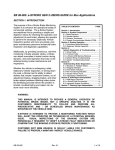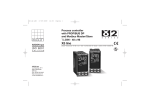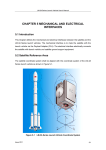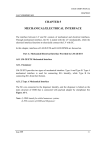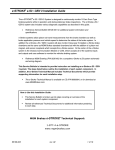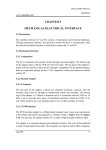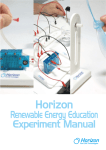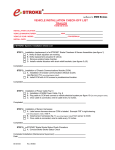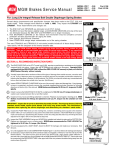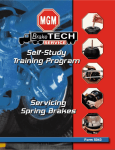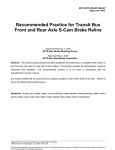Download MGM Brakes Service Manual
Transcript
MGM Brakes Service Manual MAGNUM Performance Plus Spring Brake Actuators (MJ-Series – 3.00” / 76mm “Long Stroke”) Revised - 2/2010 For: S-Cam Tamper-Resistant MAGNUM Performance Plus Spring Brake Actuators Figure 1 Your MGM Brakes Tamper-Resistant MAGNUM Performance Plus spring B A brake actuators are an important part of your braking system. While they do not require scheduled servicing, it is good preventive maintenance to make the following routine inspections (minimum of every 50,000 miles/80,400 kms) C while the vehicle is in the shop for regular servicing of other components. ! F D E G MAGNUM Performance Plus WARNING - Your MGM Brakes tamper-resistant spring brake has been factory sealed for your protection. There are no user-serviceable parts inside the spring brake chamber. If you experience any damage or failure of your spring brake chamber, remove either the entire actuator as in Section (3) of this manual, or the single (piggyback) as in Section (5) of this manual. See Section (8) of this manual for disposal instructions. Never attempt to disassemble the spring brake chamber as serious personal injury could result from accidental sudden release of the high energy spring. SECTION (1): RECOMMENDED INSPECTION POINTS (Fig. 1) A Visually inspect the exterior surfaces of the unit for signs of damage from outside sources, corrosion and/ or rust. If any of these are seen or suspected, cautiously remove the complete combination chamber by following the directions in Section (3) of this manual. Per CVSA out of service criteria, any non-manufactured hole or crack will place the vehicle out of service. B Check to ensure that the RELEASE BOLT is seated against head insert and tightened to 50-60 Lbs.Ft./68-81 Nm torque. This ensures the parking brake will have full stroke capability and seals release bolt threads, keeping out contaminants. C Ensure the BREATHER TUBE is securely engaged a minimum of 1/2-inch/13mm into the rubber elbows and glued together with a high quality rubber cement. These units must be mounted with the BREATHER TUBE facing away from the road surface (Fig. 7). Failure to comply with these installation instructions will void the MGM Brakes Warranty without remedy. D Check to ensure the SERVICE CHAMBER CLAMPBAND is evenly seated and the clampband bolt nuts are torqued to 30-35 Lbs.-Ft./41-47 Nm. E Check to ensure the MOUNTING STUD NUTS are tightened to 133-155 Lbs.-Ft./180-210 Nm torque (clockwise) and washers are in place between the nut and the bracket. F Inspect air lines, hoses and fittings attached to the chamber. Replace any damaged or leaking parts. MGM Brakes recommends the fittings be tightened to 25-30 Lbs.-Ft./34-41 Nm torque into the chamber air-inlet ports. G Inspect the PUSH-ROD to be sure it is working free, not bent, not binding and is square to the chamber bottom within ±3° in any direction at any point in the stroke of the chamber. If the PUSH-ROD is not square, make corrections by repositioning the chamber on the mounting bracket and/or by shimming the slack adjuster to the right or left on the camshaft. H Inspect the YOKE ASSEMBLY being sure the YOKE PIN is installed and locked into place with a COTTER PIN. Replace any damaged, worn or missing parts. MGM Brakes recommends the YOKE JAM NUT be tightened to 25-50 Lbs.-Ft./34-68 Nm torque. (Not Shown) I On units equipped with a DUST BOOT, check the BOOT for tears and replace as necessary. (Not Shown) 1 SECTION (2): MANUAL RELEASE PROCEDURE Figure 2 (a) Before releasing brakes, chock wheels of vehicle to prevent movement. (b) Turn the integral release bolt counter-clockwise using a 3/4-inch/19mm socket wrench (Fig. 2) until the power spring is fully caged or compressed (DO NOT USE AN IMPACT WRENCH). Full cage position requires approximately 22-23 turns for 3.00-inch/76mm stroke units. Turn Counter-Clockwise MAGNUM Performance Plus models have an MGM Brakes patented dual thread release bolt which reduces the travel of the release bolt by a factor of 2.4. In a 3.00-inch/76mm stroke unit, for instance, the parking spring is fully caged when the release bolt is up approximately 1.3 inches/33mm from the run position (Fig. 3). ! WARNING - Do not exceed this length and do not exceed 74 Lbs.-Ft./100 Nm torque on release bolt at any time or damage may occur which could prevent any further correct manual release of the spring brake chamber. NOTE - For easier turning of the release bolt, apply 95-125 psi/655-862 kPa air pressure to the air-inlet port marked “Spring” before Step (b) above. After caging, completely exhaust air from the spring chamber. SECTION (3): REMOVAL AND INSTALLATION INSTRUCTIONS FOR “COMBINATION” SPRING BRAKE CHAMBERS Figure 3 IMPORTANT - It is important when replacing any other model air brake actuator with a MAGNUM Performance Plus (MJ-Series) model actuator that both actuators on the same axle be replaced to ensure braking stability. The parking brake forces are significantly different and using two different actuators on the same axle could cause brake pull during an emergency brake application. Measure NOTE - Refer to Cam Brake Adjustment - Section (7) of this manual before removing the air brake chamber to be replaced to ensure the brake chamber being replaced will be properly installed with correct rod length. (a) Determine the manufacturer of the combination chamber to be removed from the vehicle and, following that manufacturer’s instructions exactly, manually release the spring brake completely. Instructions for MGM Brakes MAGNUM Performance Plus model single “piggyback” spring brakes having internal release bolts are given in Section (2) of this manual. Service Manuals for all other design-series of MGM Brakes piggyback/spring brakes are also available upon request. (b) Remove cotter pin from the yoke pin, knock out yoke pin, and remove both airlines from the assembly. IMPORTANT - Be sure to mark the air line from the air-inlet port marked “SPRING” for reinstallation reference. (c) Using a 15/16-inch/24mm wrench, unscrew hex nuts on mounting bolts and cautiously remove the old chamber from the mounting bracket. (d) Procedure to Cut Service Push-Rod to Proper Length. Improper installation of the new unit could result in malfunctioning brakes or premature failure of the braking system. Refer to Section (7) of this manual for proper cam brake adjustment. If the old brake chamber was properly installed, use the old brake measurement to determine the proper rod length. If the brake being removed was not properly installed or has been damaged too greatly to allow measurement, the other chamber on the same axle may be used. Otherwise, consult the vehicle manufacturer for proper rod length. Replacing a Double-Diaphragm, a MAGNUM MG-T or a MAGNUM MJ (Performance Plus) Model Spring Brake with a MAGNUM MJ (Performance Plus) Model Combination Chamber Make sure the old spring brake is manually-released fully as outlined in Step (a) above, and that the service brake push-rod is fully retracted to zero stroke or brakes “OFF” position. Then measure and record both of the following “X” and “Y” dimensions, in inches or millimeters, outward from bottom face of service brake chamber (Fig. 4): “X” Dimension - The dimension from bottom of actuator to end of push-rod. “Y” Dimension - The dimension from bottom of actuator to centerline of yoke pin. 2 Figure 4 Y X Replacing a MAGNUM MB, MB-T, MG or MG-T Model Spring Brake with a MAGNUM MJ (Performance Plus) Model Combination Chamber Figure 5 Make sure the old spring brake is fully released with 90-100 psi/ 621-690 kPa applied to the spring port. Measure and record both of the following dimensions, in inches or millimeters, outward from bottom face of service brake chamber (Fig. 4). “X” Dimension - The dimension from bottom of actuator to end of push-rod. “Y” Dimension - The dimension from bottom of actuator to centerline of yoke pin. NOTE - If the brake chamber being removed cannot be fully released by applying air pressure, the other chamber on the same axle (must be same model as one being removed) may be used for rod measurement, provided it is adjusted properly and operating correctly, and is retracted to its zero stroke position (brake fully released). Otherwise, consult the vehicle manufacturer for proper rod length. IMPORTANT - The non-pressure housing (steel housing with mounting bolts) may be standard (Fig. 5), or extra high profile (Fig. 6), on some older models. While the standard height housing will normally replace the extra high profile, it is recommended that each installation be checked for sufficient clearance with chassis components. For all Installations: Procedure to Cut Push-Rod on New Replacement Combination Chamber Figure 6 NOTE: The new service chamber push-rod must be cut to exactly duplicate the original “rod-plus-yoke” length after the yoke assembly is reinstalled on the new chamber’s push-rod. Use the same procedure for measuring the rod on the new unit as used on the unit being replaced. Refer to Section (4) for rod cutting instructions. (e) Remove hex nuts and washers on mounting bolts of new chamber, clean face of mounting bracket and install chamber on bracket with close attention given to positioning chamber air-inlet ports for alignment to vehicle air lines. Then install one washer and hex nut on each mounting bolt and, using a 15/16-inch/24mm hand wrench (DO NOT USE AN IMPACT-TYPE WRENCH), tighten nuts to MGM Brakes recommended 133-155 Lbs.-Ft./180-210 Nm torque. IMPORTANT - If it is required to reposition the air-inlet ports to assure proper mating and alignment with vehicle air lines, refer to Section (5) of this manual and follow Steps (c) through (f) very carefully. IMPORTANT - When installing any MGM Brakes MAGNUM Performance Plus model chamber it is mandatory to position the chamber so the breather tube faces away from the road surface (Fig. 7). Failure to comply will void the MGM Brakes Warranty on these models. (f) Reconnect yoke to slack adjuster, being sure the correct diameter and length of yoke pin is installed into the correct hole in the slack adjuster. Secure yoke pin with a new cotter pin. Figure 7 Yes No Road Surface Breather Tube Yes No IMPORTANT - When reconnecting to an automatic slack adjuster, follow the vehicle manufacturer’s recommendations for installation and setup for this type of slack adjuster. (g) Inspect the push-rod to be sure it is working free, not bent, not binding and is square to the chamber bottom within + 3o in any direction at any point in the stroke of the chamber. If the push-rod is not square, make corrections by repositioning the chamber on mounting bracket and/or by shimming the slack adjuster on the camshaft as required. (h) Apply sealing compound to hose fittings and reinstall both air lines to the chamber making sure each is mated to the correct air-inlet port according to markings made earlier. MGM Brakes recommends the fittings be tightened to 25-30 Lbs.-Ft./34-41 Nm torque into the chamber’s air-inlet ports. 3 (i) Using vehicle system air, charge spring brake with full line pressure (minimum 100 psi/690 kPa). Using only soapy water (NEVER ANY TYPE OF OIL!), inspect for air leaks at air lines and fittings. If bubbles appear, tighten fittings slightly, but not over 25-30 Lbs.-Ft./34-41 Nm torque. Figure 8 IMPORTANT - If service brake clampband was loosened to reposition air-inlet ports in Step (e) above, apply air to spring brake and then apply and hold foot brake treadle valve down to charge service brake chamber. Test for air leaks around circumference of service clampband with soapy water or air leak detection liquid solution. If bubbles appear, firmly tap circumference of clampband with hammer and retighten clampband nuts until leaks cease (Fig. 8). MGM Brakes recommends 30-35 Lbs.-Ft./41-47 Nm torque on clampband hex nuts. (j) Exhaust air pressure from service brake chamber and with air pressure still applied to spring brake chamber, tighten the release bolt until it is seated against the head insert and torqued to 50-60 Lbs.-Ft./68-81 Nm. This will ensure the parking brake will have full stroke capability and the release bolt threads will seal out contaminants. IMPORTANT - Be sure external breather tube is securely engaged a minimum of 1/2-inch/13mm into the rubber elbow (Fig. 9) and glued together with a high quality rubber cement. These units must be mounted with the breather tube facing away from the road surface (Fig. 7). Failure to comply with these installation instructions will void the MGM Brakes Warranty without remedy. ! WARNING - After replacement of any spring brake actuator, the pushrod stroke and actuating alignment MUST be checked to assure correct installation and foundation brake adjustment. It is very important to recognize that no foundation brake adjustments can be made at either the spring brake chamber or at the service brake chamber, and that all “stroke adjustments” MUST be made at the slack adjuster according to the specific recommendations of the foundation brake manufacturer or of the vehicle manufacturer. Figure 9 SECTION (4): PROCEDURE TO CUT THE SERVICE CHAMBER PUSHROD TO PROPER LENGTH Apply Adhesive Here 1/2-inch/ 13mm Minimum Engagement ! WARNING - Do not attempt to service or disassemble the spring chamber on any spring brake actuator. A large spring in the spring chamber having extreme force could cause serious bodily injury if it were to suddenly be released due to inadvertent removal of the clampband or tamper-resistant head. IMPORTANT - Place chocks under wheels to prevent vehicle movement before removing air-brake actuators. (a) Remove WORN or NON-FUNCTIONAL UNIT from Vehicle: Determine manufacturer and model of unit to be replaced. Refer to that manufacturer’s service manual for caging and removal instructions. (b) Make sure the spring chamber of the removed actuator is fully released (power spring caged) and the service brake push-rod is fully retracted to zero stroke position (i.e. brake fully released). Refer to Section (3), Pg. 4 of this manual if old chamber to be replaced is an MGM Brakes MB or MB-T model. (c) Measure and record the “X” and “Y” dimensions (Fig. 4). “X” Dimension - The dimension from bottom of actuator to end of push-rod. “Y” Dimension - The dimension from bottom of actuator to centerline of yoke pin. NOTE - If for some reason the spring chamber power spring cannot be caged and fully released, then the “X” and “Y” dimensions will need to be measured from the other actuator on the same axle (must be same model as the one being removed), provided it is properly adjusted and operating correctly, and is retracted to its zero stroke position (brake fully released). Otherwise, consult the vehicle manufacturer for proper rod length. 4 Figure 10 (d) Before marking push-rod to be cut on a new unit, be sure the power spring is fully caged and the push-rod is fully retracted the zero stroke position. (This may be done with the integral release bolt or by applying 90-100 psi/621-690 kPa air pressure to the spring chamber air-inlet port.) (e) Take measured “X” dimension from the removed unit and mark push-rod of new unit from the bottom of the actuator. (f) Thread yoke jam nut past mark on push-rod. Align bottom edge of nut with mark. (g) Use a sharp hack-saw and cut push-rod on the mark (Fig. 10). (h) After cutting rod, thread jam nut off to clean up cut thread. (i) Thread jam nut back onto the push-rod a sufficient length to allow assembly of the yoke. (j) Thread yoke onto the push-rod. Yoke from removed unit may be reused provided yoke pin hole is not worn. Adjust yoke to the same “Y” dimension as measured from the removed unit. (k) Hold yoke to prevent it from turning and tighten jam nut against yoke to 25-50 Lbs.-Ft./34-68 Nm torque. To INSTALL NEW UNIT on Vehicle: Refer to the MGM Brakes Service Manual for the model that is being installed. Refer to Section (3), Step (a) of this manual. IMPORTANT - When installing any MGM Brakes model with a breather tube, it is mandatory to position the breather tube facing away from the road surface (Fig. 7). Failure to comply will void the MGM Brakes Warranty on these models. IMPORTANT - When making a reconnection to an automatic slack adjuster, follow the vehicle manufacturer’s recommendations for installation and setup. SECTION (5): REMOVAL AND INSTALLATION INSTRUCTIONS FOR SINGLE (PIGGYBACK) SPRING BRAKE CHAMBERS IMPORTANT - It is important when replacing any other model air brake actuator with a MAGNUM Performance Plus (MJ-Series) model actuator that both actuators on the same axle be replaced to ensure braking stability. The parking brake forces are significantly different and using two different actuators on the same axle could cause brake pull during an emergency brake application. Figure 11 The replacement of a single (piggyback) spring brake chamber can be done without the removal of the entire “combination” spring brake from the vehicle. The procedure can be made easier by “locking off” the service chamber pushrod. To do this, engage the service brake by applying the driver’s foot brake treadle valve and, while applied, clamp vise-grip pliers onto push-rod to prevent rod from retracting when air pressure is released (Fig. 11). (a) Determine manufacturer of single spring brake chamber to be removed from vehicle and following that manufacturer’s instructions exactly, manually release the spring brake completely. Instructions for MGM Brakes MAGNUM Performance Plus (MJ-Series) single (piggyback) spring brakes having integral release bolts are given in Section (2) of this manual. Service Manuals for all other design-series of MGM Brakes single (piggyback) spring brakes are also available upon request. (b) Remove both air lines from chamber. IMPORTANT - Be sure to mark the air line from the air-inlet port marked “SPRING” for reinstallation reference. (c) On any MGM Brakes model fitted with an external breather tube, disconnect the tube and elbow from the service chamber housing (Fig. 12). 5 (d) Using a 9/16-inch/14mm wrench or socket, remove the nuts on service clampband. Next, while holding the single (piggyback) chamber securely in place, remove clampband (Fig. 13), then carefully separate and remove the single (piggyback) chamber from the service chamber. Figure 12 IMPORTANT - At this time take the opportunity to inspect all parts in the service chamber (especially the diaphragm and return spring) and replace any parts which may be damaged or worn. Use only genuine MGM Brakes engineered replacement parts! (e) Make sure new single (piggyback) spring brake chamber is fully released as outlined in Section (2) of this manual. Position diaphragm in bottom recess of chamber (Fig. 14) and, with very close attention taken to assure all mating parts are aligned straight and the air-inlet ports are positioned to mate with vehicle air supply lines, replace service clampband (Fig. 13). (f) Reinstall clampband bolts and nuts. Alternately tighten each nut in 5-10 Lbs.-Ft./7-14 Nm torque increments while constantly rechecking mating parts alignment. If realignment is required, loosen clampband nuts and repeat Step (e) above. Firmly tap around circumference of clampband with hammer to assure full seating of clampband (Fig. 8) and tighten nuts to 30-35 Lbs.-Ft./41-47 Nm torque. Figure 13 (g) A p p l y s e a l i n g c o m p o u n d t o h o s e f i t t i n g s a n d r e i n s t a l l b o t h a i r l i n e s t o c h a m b e r, m a k i n g s u r e e a c h i s m a t e d t o c o r r e c t a i r - i n l e t p o r t a c c o r d i n g t o m a r k i n g s m a d e e a r l i e r. MGM Brakes recommends the fittings be tightened to 25-30 Lbs.-Ft./34-41 Nm torque into the chamber’s air-inlet ports. (h) Using vehicle system air, charge parking brake with full line pressure (minimum 100 psi/690 kPa). Using only soapy water (NEVER ANY TYPE OF OIL!), inspect for air leaks at air lines and fittings. If bubbles appear, tighten fittings slightly, but not over 25-30 Lbs.-Ft./34-41 Nm torque. (i) With spring brake still fully charged with full line pressure, apply and hold foot brake treadle valve down to charge service brake chamber. IMPORTANT - At this time, remove vise-grip pliers (Fig. 11) from the service chamber push-rod so it can return to a normal position in chamber when service brake is released. Test for air leaks around circumference of service clampband with soapy water or air leak detection liquid solution. If bubbles appear, firmly tap circumference of clampband with hammer and retighten clampband nuts until leaks cease (Fig. 8). MGM Brakes recommends 30-35 Lbs.-Ft./41-47 Nm torque on clampband hex nuts. Figure 14 (j) On any MGM Brakes MAGNUM Performance Plus model fitted with an external breather tube, wipe open end of connector tube clean to be sure no oil is present, apply a good quality rubber cement to the tube and reinsert tube into both of the flexible elbows with a minimum of 1/2-inch/13mm engagement (Fig. 9). If old single (piggyback) spring brake was not equipped with an external breather tube, drill a 1/2-inch/13mm diameter hole 1-inch/25mm from the top ‘lip’ of the non-pressure chamber (Fig. 15), at a point closest to the centerline between the air-inlet ports, on the side which will face away from the road surface (Fig. 7). Remove burrs around the hole and install a new rubber elbow into the non-pressure chamber. Wipe open end of connector tube clean to be sure no oil is present and apply a good quality rubber cement to the tube. Insert Figure 15 the tube into the flexible elbow with a minimum of 1/2-inch/13mm engagement into elbow (Fig. 9). IMPORTANT - These units must be operated with the breather tube facing away from the road surface (Fig. 7) and the tube glued securely into the rubber elbows. Failure to comply with these installation instructions will void the MGM Brakes Warranty without remedy. 6 (k) Exhaust air pressure from service brake chamber and with air pressure still applied to the spring brake, tighten the release bolt until it is seated against the head insert and torque to 35-45 Lbs.Ft./47-61 Nm. This will ensure the parking brake will have full stroke capability and the release bolt threads will seal out contaminants. IMPORTANT - Release bolt must be properly tightened for correct, full functioning of the spring brake. SECTION (6): REMOVAL AND INSTALLATION INSTRUCTIONS FOR SERVICE BRAKE DIAPHRAGM ! WARNING - When servicing a 3-inch/76mm “Long Stroke” model brake, be sure to replace with the correct diaphragm. Installation of a standard (2.50-inch/64mm) stroke diaphragm into a 3.0-inch/76mm “Long Stroke” chamber will result in short stroking and could result in air leaks and failure of the unit. IMPORTANT - All MAGNUM Performance Plus (MJ-Series) spring brake actuators MUST use 3.0-inch/76mm “Long Stroke” diaphragms. (a) Follow all instructions given in Section (5) of this manual, paying close attention to positioning the new diaphragm at Step (e). Use only genuine MGM Brakes-engineered replacement diaphragms! BRAKES “OFF” - NOT APPLIED PROPERLY ADJUSTED BRAKES “ON” - APPLIED To check brake adjustment, apply 90-100 psi/621-690 kPa air pressure to the service chamber. Consult the vehicle manufacturer for the correct angle between the slack adjuster arm and push-rod and/or the pushrod length. This is necessary since different dimensions are required for automatic or manual slacks, various slack lengths and different slack adjuster manufacturers. Angle must always be greater than 90° due to various slack adjuster lengths and installation setups. (Refer to axle or OEM manufacturer’s manual for recommended angle). Free stroke should be as short as possible with no lining to drum contact. IMPROPERLY ADJUSTED BRAKES “ON” - APPLIED (Maximum recommended readjustment stroke has been exceeded) MGM Brakes “Stroke Alert” Visible (Excessive Stroke Warning) Magnum Performance Plus See chart on right for recommended readjustment stroke Approx. Diaphragm O.D. Inches MM CVSA Rated Stroke Maximum of Chamber Stroke with Recommended Brakes Stroke Adjusted Inches MM Inches MM 20 6.50 165 3.00 76 24 7.00 175 3.00 76 30 8.00 200 3.00 76 36 9.00 230 3.00 76 SHOULD BE AS SHORT AS POSSIBLE WITHOUT BRAKES DRAGGING 2.50 64 2.50 64 2.50 64 2.50 64 SOURCE: MVMA (Motor Vehicle Manufacturers Association) IMPORTANT - It may not be necessary to disconnect air lines from the spring brake during this procedure as long as correct parts are used and alignment can be obtained during reassembly operation. SECTION (7): CAM BRAKE ADJUSTMENT - ALL SPRING BRAKE AND SERVICE BRAKE ACTUATORS NOTE: The following procedure is recommended for proper adjustment. 7 SECTION (8): RECOMMENDED SPRING BRAKE ACTUATOR DISARMING PROCEDURE All retired spring brake actuators should be safely disarmed before they are disposed of to prevent serious personal injury from accidental sudden release of the high energy power spring (as much as 3200 lbs./1450 kgs.) in the spring (or parking) chamber. To disarm the unit, remove it from the vehicle following the instructions in Section (3) for combination chambers, or Section (5) for single (piggyback) chambers. Be sure to cage the spring. ! WARNING - NEVER attempt to remove the head which contains the power spring. Observe all safety precautions. Place the unit in a steel container and use an acetylene torch to cut a hole through the head housing the power spring. Cut completely through at least two spring coils. The steel container MUST have openings to expose the head where it is to be cut with the acetylene torch, and it MUST be strong enough to prevent parts from hurtling out should the unit suddenly separate before it is safely disarmed. It is the user’s responsibility to ensure the steel container is safe.* *Information concerning a suitable container is available from your MGM Brakes representative. Serving our customers for over 50 years! www.MGMBrakes.com MGM Brakes A Division of Indian Head Industries, Inc. 8530 Cliff Cameron Drive • Charlotte, NC 28269-9786 (704) 547-7411 • (800) 527-1534 • (704) 547-9367 Fax email: [email protected] Form 5044 - Revised 2/2010 ©2001 MGM Brakes All Rights Reserved. 8 Printed in U.S.A.










